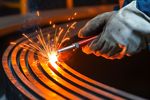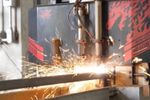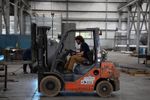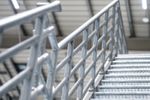Custom metal fabrication is both a specialized and varied profession. On the one hand, a custom metal fabricator is always doing custom jobs, which have to be manufactured to meet what are often strict tolerances required by the client. On the other hand, custom metal fabricators work with many industries on a lot of different applications using several types of metals.
We’ve written quite a bit before about industries and applications for custom metal fabrication, but we haven’t said much to date about the metals commonly used by a custom metal fabricator. Which led us to thinking that it’s about time we talked about the four major metals used in custom metal fabrication in more detail: carbon steel, stainless steel, aluminum, and copper. After all, there wouldn’t be much to custom metal fabrication without the metals themselves.
No. 1 – Carbon Steel Fabrication
Carbon steel is a prevalent form of steel, especially when it comes to industrial applications. It’s relatively easy to work with and can be finished in a number of ways so that it will stand up to the stresses encountered in industrial environments.
 ] Structural steel components that have been finished to protect them against the elements.
] Structural steel components that have been finished to protect them against the elements.
Most of the carbon steel you see being used in industrial applications is what is called “mild,” “low-carbon,” or “plain-carbon” steel. Carbon content in this steel is below 0.3 percent, typically in the 0.16–0.29 percent range. Somewhat pliable, it can be easily bent, rolled, welded, and formed. Steel with a higher carbon content becomes brittle and is difficult to weld.
Carbon steel is typically used for industrial applications such as structural steel, ducts, tanks, and industrial access equipment. These applications require a lot of surface area and generally have to be thick and heavy, which makes the relatively inexpensive carbon steel a good option.
Left on their own, carbon steel structures will corrode in short order. That’s why it’s important to galvanize carbon steel components or finish them in some other way, such as with high-temperature paint, to protect them from the elements. This is doubly important in industrial environments, which are often highly corrosive.
No. 2 – Stainless Steel Fabrication
 A stainless steel surge tank.
A stainless steel surge tank.
Stainless steel is a steel alloy that has a high content of chromium — generally more than 10.5 percent. This prevents it from rusting and generally staining (there are some environments, however, such as ones with low-oxygen or high-salt, where stainless steel can in fact stain).
Like carbon steel, stainless steel is relatively easy to work with. It bends readily and is receptive to welding. However, it is significantly more expensive than carbon steel — anywhere from 30–60 percent more — which is why it’s reserved for applications where its corrosion-resistant properties are required.
As far as industrial applications are concerned, stainless steel is typically used to make tanks, bins, and hoppers for food processing. Facilities that produce dry food (e.g., grain) and wet foodstuffs (e.g., beer or molasses) both make use of stainless steel containers.
 A custom-fabricated aluminum ladder
A custom-fabricated aluminum ladder
No. 3 – Aluminum Fabrication
Like stainless steel, aluminum resists corrosion and, as a rule of thumb, is generally more resilient in this regard than all but the most expensive stainless steels. Aluminum is also very lightweight, which has made it an important material for industries that rely on metal but also need to shed weight, such as the aerospace and automotive industries.
Aluminum is also a popular material for industrial and military access equipment, especially caged ladders. Aluminum ladders are lightweight, easy to install, and don’t require as much maintenance as carbon-steel ladders and platforms.
No. 4 – Copper Fabrication
Of all the metals on this list, copper is the oldest when it comes to human applications. As a species, we’ve been making things out of copper for over 10,000 years, largely due to the fact that it is easy to work with and is one of the few native metals, meaning that it can be found on its own in nature. (Steel, on the other hand, must be created by removing impurities from iron ore and aluminum is typically found combined with other minerals, despite its abundance.)
We don’t get a lot of inquiries from industrial companies about copper fabrication, but we receive local requests here in Alabama for decorative copper work from time to time. When we do, we’re happy to oblige. It’s a chance for us to show our arty side and we’re not ashamed of that at all.
 This outdoor chimney features a beautiful copper chimney cover.
This outdoor chimney features a beautiful copper chimney cover.
Some of the things you can make with copper include decorative chimney covers, copper roof accents, and trim for gates and fences. Whether these pieces are for commercial or residential applications, it’s a lot smaller-scale work than we’re used to, but we enjoy working with copper.
The Diversity of Custom Metal Fabrication
Custom metal fabrication encompasses a diverse array of projects and several different metals. Everything from a carbon-steel duct to a stainless-steel tank to an aluminum caged ladder to copper flashing should be in a custom metal fabricator’s wheelhouse.
Whatever you’re looking for, chances are we’ve done it before and will happily do it again. When you’re a full-service custom metal fabrication shop like we are, you get requests for a wide range of jobs and develop the expertise to fulfill them.
That’s why we like to say, “Call us today and give us a chance to say, ‘Yes, we can do that!’” The number’s 1-800-989-1300 if you’d like to give us a try.





